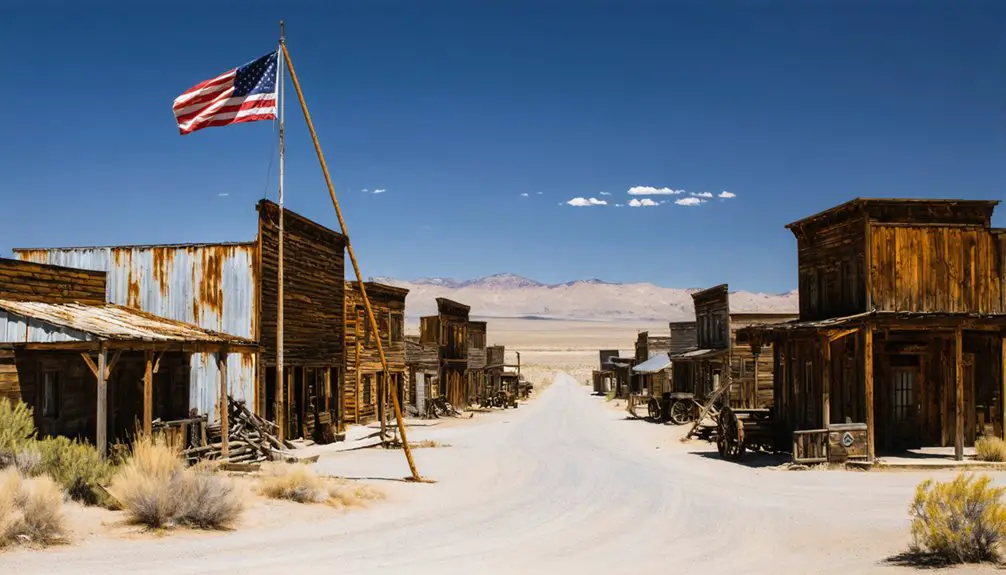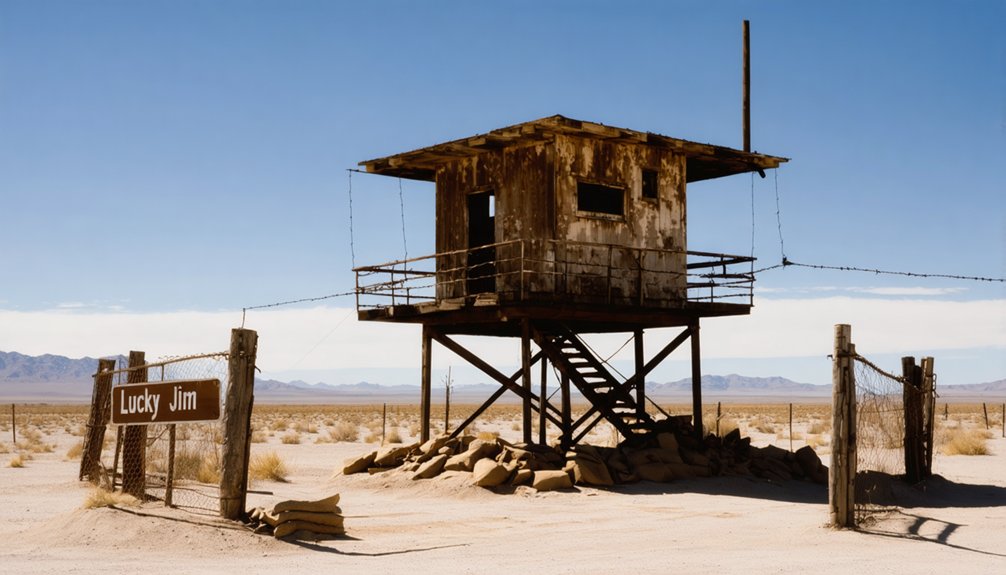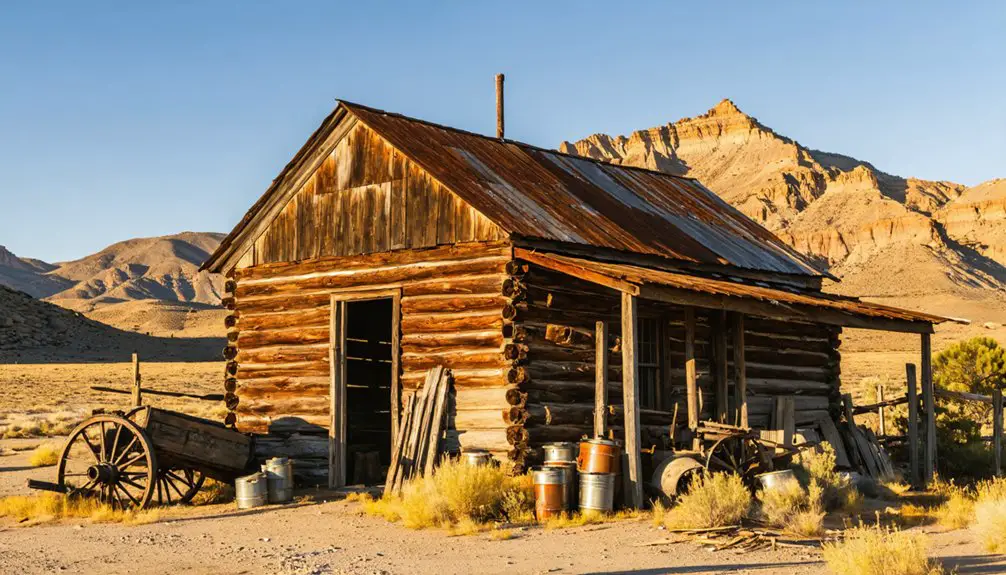You’ll find Lucky Jim Camp nestled in Nevada’s El Dorado Canyon, where it emerged in 1862 as a Confederate-aligned mining settlement during the Civil War. Just a mile from the Union-sympathizing Buster Falls camp, tensions between the settlements remained largely symbolic as miners focused on extracting gold and silver. The camp thrived until the late 1870s, supported by the nearby Techatticup Mine, though today only bare earth marks where this politically charged ghost town once stood.
Key Takeaways
- Lucky Jim Camp was established in 1862 as a Confederate-sympathizing mining settlement during the Civil War in El Dorado Canyon, Nevada Territory.
- Located at coordinates 35.7022°N, -114.8033°W, the camp served as a base for mining operations near the Techatticup Mine.
- The settlement thrived on gold and silver mining, with operations significantly improving after the 1863 introduction of a ten-stamp mill.
- Though politically divided from nearby Union-aligned Buster Falls camp, both settlements maintained relative peace while pursuing mineral wealth.
- Today, the site shows no visible structures, with natural reclamation having erased physical evidence of the once-active mining camp.
The Birth of a Civil War Era Mining Settlement
While the Civil War divided the nation in 1862, a new mining settlement called Lucky Jim Camp emerged in El Dorado Canyon, then part of New Mexico Territory.
You’ll find the camp’s unique Settlement Dynamics reflected the broader national conflict, as Confederate sympathizers made it their home while Union loyalists established rival Buster Falls camp just a mile upriver.
Though tensions occasionally flared between the camps, with incidents like flag vandalism and heated disputes, the miners primarily focused on their search for valuable ore.
Despite political divisions, the miners’ shared drive for riches kept conflicts in check as they hunted for precious minerals.
The remote location attracted a diverse mix of settlers, including army deserters seeking refuge from the Civil War.
Despite their political differences, the few hundred residents maintained a relatively peaceful coexistence, bound together by their shared pursuit of mineral wealth in the rugged Colorado Mining District.
The establishment of El Dorado City near the camp in late 1863 brought industrial mining operations to the area.
Colonel Vineyard’s construction of a ten-stamp mill helped reduce ore shipping costs to San Francisco by half.
Location Deep in El Dorado Canyon
Deep within El Dorado Canyon at 2,444 feet above sea level, Lucky Jim Camp occupied a strategic position on the north side of this rugged Nevada terrain.
You’ll find its historical geography defined by its placement above January Wash and south of the bustling Techatticup Mine, near coordinates 35.7022°N, -114.8033°W.
The camp’s location proved ideal for mining logistics, sitting midway through the canyon where you could access both upstream operations and downstream connections to the Colorado River.
During the Civil War era, Confederate sympathizing miners made this location their home, establishing a distinct community separate from Union supporters.
This positioning let miners efficiently transport supplies up from riverboat landings while shipping ore in return. Travelers heading to Nelson’s Landing would pass through this area when moving between mining operations.
The camp’s elevation and sheltered position on stable canyon ledges, combined with its proximity to essential water sources like Huse Spring, made it a practical choice for settlement during the 1860s mining boom.
Confederate Sympathies and Local Tensions
You’ll find Lucky Jim Camp was one of two politically-divided mining settlements that emerged in El Dorado Canyon during the Civil War years, with Confederate sympathizers establishing Lucky Jim while Union loyalists set up rival Buster Falls about a mile away.
The camps were supported by a bustling post office service that operated from 1865 to 1867, facilitating communication between the divided settlements.
Though the camps frequently quarreled over their opposing allegiances, their conflicts remained largely symbolic and personal rather than escalating into major violence. The situation mirrored the experience of Virginia City miners, where Confederate celebrations were suppressed by Union-supporting fire brigades.
The camps’ stark political division reflected how deeply the Civil War’s influence reached even remote Western frontier communities, with Lucky Jim Camp maintaining its distinct Confederate identity until both settlements were eventually abandoned after the war.
Civil War Mining Divide
During the Civil War era, Lucky Jim Camp emerged as a distinctive Confederate stronghold in El Dorado Canyon, Nevada, just south of the Techatticup Mine.
Despite its remote location, you’ll find this mining settlement reflected the nation’s deep political divide, with Confederate sympathizers establishing their own community separate from Union-supporting camps like Buster Falls. The camp’s strategic location allowed miners to access the rich gold deposits that would later produce $1.5 million from nearby mines. The area’s untried murders and lawlessness complicated the already tense political atmosphere.
The divided loyalties manifested in three key ways:
- Mining technology and labor dynamics split along political lines, though shared economic interests often required cooperation.
- Occasional skirmishes broke out between camps, including shots fired at Confederate flags by Union supporters.
- Letters requesting military protection in 1862 led to troops arriving by 1863 to maintain order among the politically divided miners.
Wartime Camp Rivalries
While the nation fought its bloodiest conflict, the remote mining camps of Lucky Jim and Buster Falls mirrored America’s divide in miniature along El Dorado Canyon.
You’d find Confederate sympathizers at Lucky Jim Camp, while just a mile up the canyon, Union loyalists called Buster Falls home.
The camp rivalries manifested in colorful ways – most importantly when Bill Piette from Buster Falls took potshots at Lucky Jim’s Confederate flag.
Though miner tensions occasionally erupted into fistfights, the camps’ antagonism remained largely symbolic rather than deadly.
Despite their opposing loyalties, these isolated communities managed to coexist without major bloodshed.
The U.S. Army later established Camp El Dorado nearby, though it focused on external threats rather than mediating the camps’ political differences.
Post office operations served both camps from 1865 to 1867, providing a shared connection to the outside world.
Mining Operations and Economic Impact
As prospectors discovered rich deposits of gold and silver in El Dorado Canyon, Lucky Jim Camp emerged in 1862 as a significant mining settlement situated 2,444 feet above sea level.
Confederate sympathizers made Lucky Jim Camp their base of operations, while Union supporters established Buster Falls camp a mile away.
You’ll find that gold extraction operations centered around nearby mines like Techatticup, with ore transportation initially requiring costly shipments to distant mills in San Francisco.
The arrival of a ten-stamp mill in 1863 revolutionized the camp’s economic prospects:
- Processing costs dropped by half when the mill began operating at El Dorado City
- The mill used salvaged parts from California’s Mother Lode region
- Local processing sparked new mining investment and reactivated dormant claims
This innovation shifted the region’s economic center to El Dorado City, though mining continued at Lucky Jim through the early 20th century, adapting to technological improvements and market demands.
Daily Life in Lucky Jim Camp

If you’d visited Lucky Jim Camp in its heyday, you’d have found yourself among Confederate-sympathizing miners living in basic wooden shacks and tents positioned at 2,444 feet elevation above January Wash.
You’d have noticed the stark social divisions between Lucky Jim’s residents and those of nearby Buster Falls camp, just a mile up the canyon, where Union supporters made their home.
The harsh desert climate and remote location meant you’d have relied heavily on the nearby Huse Spring and El Dorado Canyon confluence for water, while forming close bonds with fellow Confederate-aligned campmates for survival and support.
Living Quarters and Shelter
The harsh realities of desert mining life shaped the living quarters at Lucky Jim Camp, where shelter ranged from basic canvas tents to rough-hewn wooden shacks.
You’d find miners adapting to cramped spaces and extreme temperatures, with shelter materials varying based on availability and permanence needs. Most structures were sparsely furnished and communally shared, offering minimal protection from the constant dust and debris of nearby mining operations.
- Canvas and animal hide tents provided quick, temporary housing during initial camp establishment.
- Wooden shacks built from local timber or salvaged mine materials offered more permanent solutions.
- Stone or adobe cabins appeared near water sources when materials and skilled builders were available.
Living conditions demanded resourcefulness, with miners positioning their dwellings to maximize shade and protection from harsh desert elements while maintaining quick access to escape routes.
Mining Camp Social Structure
Life in Lucky Jim Camp revolved around a distinct social hierarchy, where mine owners and operators held the highest status while directing the camp’s economic fortunes.
The camp’s social divisions were particularly notable during the Civil War era, as Confederate sympathies set it apart from neighboring Union-aligned settlements like Buster Falls.
You’d find a diverse labor hierarchy at work, with experienced miners forming the core workforce while transient laborers moved in and out based on mining prospects.
Community roles extended beyond the mines, with essential support personnel like blacksmiths and teamsters maintaining the camp’s operations.
Social and political affiliations shaped daily interactions, particularly in communal gathering spots like saloons where cultural exchanges and conflict resolution played out.
The camp’s economic disparities were evident in the stark contrast between mine owners and the working-class miners who formed the backbone of the community.
The Rise and Fall of Silver Production
Mining operations at Lucky Jim Camp sprang to life in 1862 when prospectors discovered rich silver veins within Nevada’s El Dorado Canyon.
You’ll find the camp’s silver ore extraction evolved rapidly with mining technology advancements, particularly after John R. Vineyard’s game-changing ten-stamp mill arrived in 1863.
The economic viability of Lucky Jim’s resource extraction hinged on three key factors:
- The mill’s ability to process ore locally, cutting costs by 50%
- High-grade ores worth up to $300 per ton during peak periods
- Abundant local resources including water, wood, and flux materials
The regional trade flourished until the late 1870s, though Civil War tensions among Confederate-sympathizing miners disrupted operations.
Despite sporadic production continuing until World War II, Lucky Jim’s historical significance now rests in its ghost town status.
Territorial Changes and Governance

Lucky Jim Camp emerged in 1862 within New Mexico Territory’s boundaries, though you’ll find it was quickly caught up in the region’s shifting territorial control as the American West reorganized.
The camp’s earliest miners showed strong Confederate sympathies during the Civil War, leading to tensions with Union supporters at nearby Buster Falls until the U.S. Army established Camp El Dorado in 1867 to maintain order.
Early Territorial Status
When first established in 1862, Lucky Jim Camp fell within New Mexico Territory‘s boundaries, though the camp’s remote location meant territorial governance held minimal sway over daily operations.
Mining autonomy prevailed as miners created their own community structures and agreements for maintaining order.
The camp’s early governance reflected the complex territorial dynamics of the Civil War era, with three key developments shaping its administrative evolution:
- The camp remained under New Mexico Territory control initially, even after Nevada Territory’s creation in 1861.
- By mid-1860s, the region underwent reorganization under Arizona Territory (1863) and later Nevada statehood (1864).
- Federal interest increased during the Civil War period due to the area’s strategic importance and valuable mineral resources.
Political Border Evolution
As territorial boundaries shifted across the American Southwest in the early 1860s, Lucky Jim Camp‘s political jurisdiction underwent several dramatic changes.
You’ll find that the camp’s location, originally under Utah Territory control, changed to Nevada Territory in 1861, and finally to the state of Nevada in 1864.
The area’s complex political alliances during the Civil War era created unique governance challenges, with Lucky Jim Camp’s Confederate sympathizers contrasting sharply with neighboring Union-aligned settlements.
These territorial disputes and divided loyalties influenced how mining districts were governed and how county boundaries were eventually drawn.
When Clark County was established, it absorbed Lucky Jim Camp’s site, marking the end of the fluid frontier-era boundaries and establishing the more structured local government system that exists today.
Administrative Control Shifts
The establishment of New Mexico Territory’s governance marked Lucky Jim Camp‘s founding in 1862, setting the stage for multiple administrative shifts over the following decades.
You’ll find the camp’s territorial governance shifted from New Mexico to Arizona Territory by 1865, before finally settling under Nevada state control in the late 1860s.
Key administrative changes included:
- El Dorado Canyon’s post office establishment in 1865-1867, bringing federal oversight
- U.S. Army’s Camp El Dorado presence from 1867-1869, providing military protection
- Transfer to Clark County, Nevada jurisdiction with continued postal services through 1907
These administrative influences transformed Lucky Jim Camp from a Confederate-sympathizing mining outpost to an integrated part of Nevada’s regulated mining economy, showcasing how territorial governance evolved to support frontier development.
Military Presence and Security Measures

During the American Civil War, Lucky Jim Camp emerged as a notable Confederate stronghold amid Nevada’s mining territory, prompting significant military attention and security measures.
You’ll find evidence of the military strategy in the wagon road troops constructed between Hiko and El Dorado, which secured essential supply routes for both military and mining operations.
Just a mile away, Union sympathizers established Buster Falls camp, creating a tense divide that required careful military oversight.
To maintain order, Company D of the 9th U.S. Infantry arrived in 1867, establishing a garrison at El Dorado. They protected steamboat shipments along the Colorado River, secured mining claims, and prevented conflicts between opposing factions.
The military presence effectively deterred both Native American threats and potential clashes between Confederate and Union supporters.
The Legacy of Lucky Jim Camp Today
While military operations at Lucky Jim Camp ceased long ago, today you’ll find little physical evidence of this once-bustling Confederate mining settlement.
Located at 2,444 feet elevation in Clark County, Nevada, the site has surrendered to natural reclamation, with no structures remaining visible from satellite imagery.
Time and nature have erased all traces of Lucky Jim Camp, leaving only bare earth visible from above Nevada’s desert floor.
The camp’s cultural heritage lives on primarily through:
- Historical documentation of its role in the Colorado Mining District during the Civil War era
- Local mining records that showcase its connection to the Techatticup Mine and El Dorado City
- Specialized research highlighting its unique position as a Confederate-sympathizing camp in Nevada’s mining history
Unlike more developed ghost town tourism sites such as Nelson and St. Thomas, Lucky Jim Camp remains unmarked and largely forgotten, with no preservation efforts or commemorative markers in place.
Neighboring Mining Communities and Relations
Nestled within El Dorado Canyon‘s rugged terrain, Lucky Jim Camp existed among a fascinating network of Civil War-era mining settlements that reflected America’s deep political divisions.
You’ll find that mining alliances formed along political lines, with Confederate-sympathizing Lucky Jim Camp sitting just a mile downstream from Union-loyal Buster Falls.
Despite their ideological differences, these communities maintained an uneasy coexistence, linked by their shared dependence on El Dorado City’s stamp mill and the region’s rich mineral deposits.
Resource sharing became a necessity, as both camps relied on the same water sources and processing facilities.
The camps’ complex relationship exemplified how economic practicality often trumped political tensions, with miners from opposing camps working the same valuable deposits in the Colorado Mining District.
Frequently Asked Questions
How Did Lucky Jim Camp Get Its Name?
You’ll find the camp’s origin name significance remains a mystery – while it likely referred to a miner or prospector named Jim, no definitive historical records confirm the exact naming story.
What Was the Estimated Peak Population of Lucky Jim Camp?
While exact peak demographics weren’t recorded, you’d find the camp likely housed between 50-200 residents during its height, based on typical mining techniques and regional camp patterns of the 1860s.
Were There Any Notable Gunfights Between Lucky Jim and Buster Falls?
You won’t find any credible records of gunfights between Lucky Jim Camp and Buster Falls, despite their Civil War rivalries. While they held opposing sympathies, history shows no documented armed clashes between them.
What Natural Water Sources Did the Camp Use?
You’d find they drew water from Huse Spring and January Wash for their mining operations and water supply. The camp’s location near these sources guaranteed access to both spring water and runoff.
Did Any Famous Historical Figures Visit Lucky Jim Camp?
Like a faded photograph lost to time, you won’t find records of any famous visitors at this site. Historical significance stems from its Confederate-sympathizing miners, but no notable figures documented visits here.
References
- https://kids.kiddle.co/Lucky_Jim_Camp
- https://en.wikipedia.org/wiki/Lucky_Jim_Camp
- https://www.nvexpeditions.com/mineral/luckyboy.php
- https://en.wikipedia.org/wiki/El_Dorado_Canyon_(Nevada)
- https://forgottennevada.org/sites/aurora.html
- https://civilwartalk.com/threads/the-american-civil-war-touched-the-most-remote-places-of-the-country-nevada.165893/
- https://digital-desert.com/eldorado-canyon/eldorado-searchlight-05.html
- https://mapcarta.com/23360920
- https://topoquest.com/place-detail.php?id=847145
- https://www.topozone.com/nevada/clark-nv/city/lucky-jim-camp/



